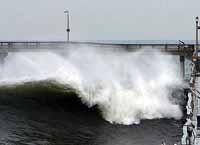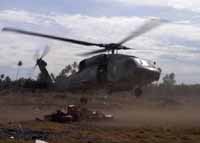WASHINGTON, Jan. 2, 2005 - The response to the disaster that struck Indian Ocean nations "is multinational and will grow in size and shape" as more information comes to light, officials at U.S. Pacific Command in Hawaii said today.
"All our services are providing some level of support to the host nations," said Navy Capt. Rodger Welch, an official with the command's operations branch.
The number of U.S. military personnel helping Indonesia, Sri Lanka, Thailand, India and the Maldives continues to increase. Officials in the region expect the number of dead from the earthquake/tsunami to reach 150,000. Indonesian officials said the number of dead in Aceh province alone could reach 100,000.
Navy aircraft began delivering supplies to the hardest-hit region of Aceh on Dec. 31, officials said. Navy aviators continued the missions Jan. 1 and today despite bad weather, and being limited to visual flight rules due to the lack of radars in the region.
Helicopters from the Abraham Lincoln Carrier Battle Group flew 12 sorties into Aceh province. Two C-130s delivered U.S. Agency for International Development supplies into the airports at Banda Aceh. There were 10 helicopter sorties from the Lincoln into the hard-hit area of Meulaboh.
In Sri Lanka, 200 Marine Corps engineers from Okinawa, Japan, will arrive to help the Sri Lankan government unsnarl the logistics problems. Aid is piling up in the capital of Colombo. However, roads and railroads in the affected region have been washed out. The Marines will help the Sri Lankans repair the infrastructure and get supplies moving, Welch said. Sri Lanka has lost at least 25,000 people in the disaster, according to officials.
In the last 24 hours, the U.S. survey team completed its assessment of Sri Lanka southeastern coast. The group met with senior Sri Lankan leaders to prioritize U.S. efforts, and two C-130s airlifted air traffic control equipment into the island nation. Marine helicopters will arrive in Sri Lanka Jan. 3, helping to eliminate the bottleneck that exists at the airport in Sri Lanka.
In Thailand, five C-130 sorties delivered 85,000 pounds of supplies in the last day. In addition, the aircraft transported 17 German citizens out of Phuket for medical treatment.
Joint Task Force 536 commander Marine Lt. Gen. Robert Blackman has arrived in Thailand and is speaking with Thai officials in Bangkok. The joint task force is fully operational at Utapao, Thailand.
U.S. teams continue their assessments in the country and continue to ship supplies where they are needed. U.S. officials across the region are working closely with local nations, nongovernmental agencies and international organizations to ensure aid is flowing to where it is needed.
Logistical bottlenecks are occurring because the infrastructure in many places simply is gone. More aid continues to arrive. The Bonhomme Richard Expeditionary Strike Group is entering the area and will soon join the effort. Some of the assets in the group will go to Indonesia, some to Sri Lanka. Other ships in the group will go where needed, Welch said.
Six U.S. maritime pre-positioning ships will enter the region in the next six days. The large cargo ships carry food, fresh water and other relief supplies. The ships normally contain enough equipment and supplies to support 15,000 Marines for one month, officials in Washington said. The ships have water purification machines and evaporators capable of producing more than 100,000 gallons of potable water per day, and pumping it to shore from up to two miles away. The ships also carry road-making supplies, electrical power generators and a many other emergency supplies and equipment.
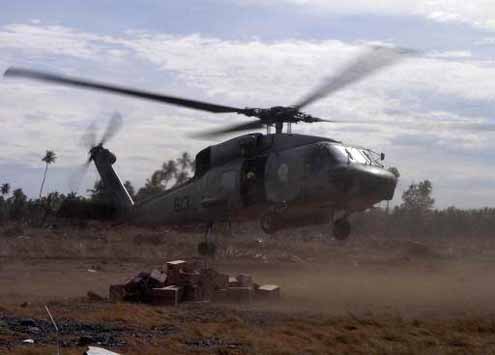
Indonesian Armed Forces unload supplies from a U.S. Navy SH-60F Seahawk Helicopter, assigned to the "Golden Falcons" of Helicopter Anti-Submarine Squadron Two (HS-2), in the village of Kewde Teunem, on the island of Sumatra, Indonesia, on Jan. 2, 2005. The Indonesian troops, along with Sailors from USS ABRAHAM LINCOLN (CVN 72), are conducting humanitarian relief operations in the wake of the tsunami that struck the Indian Ocean region. The Abraham Lincoln Carrier Strike Group is currently operating in the Indian Ocean off the coasts of Indonesia and Thailand. DoD photo by Photographer's Mate 2nd Class (AW/SW/PJ) Philip A. McDaniel, U.S. Navy. (Released)
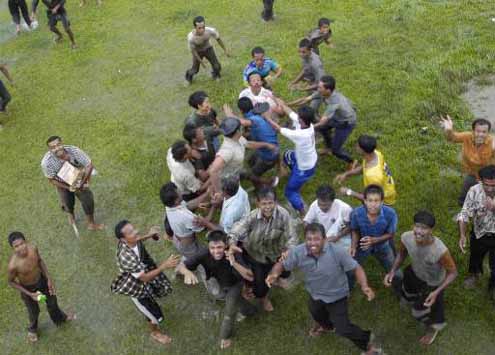
Indonesian villagers on the island of Sumatra catch supplies being dropped from a U.S. Navy SH-60F Seahawk Helicopter, assigned to the "Golden Falcons" of Helicopter Anti-Submarine Squadron Two (HS-2), on Jan. 1, 2005. Helicopters assigned to Carrier Air Wing Two (CVW-2) and Sailors from USS ABRAHAM LINCOLN (CVN 72) are conducting humanitarian relief operations in the wake of the tsunami that struck the Indian Ocean region. The Abraham Lincoln Carrier Strike Group is currently operating in the Indian Ocean off the coasts of Indonesia and Thailand. DoD photo by Photographer's Mate Airman Patrick M. Bonafede, U.S. Navy. (Released)
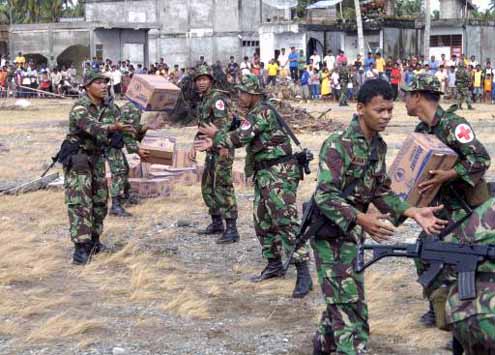
Indonesian Armed Forces unload relief supplies in the village of Kewde Teunem on the island of Sumatra, Indonesia, on Jan. 2, 2005, during humanitarian relief operations being conducted with Sailors from USS ABRAHAM LINCOLN (CVN 72), in the wake of the tsunami that struck the Indian Ocean region. The Abraham Lincoln Carrier Strike Group is currently operating in the Indian Ocean off the coasts of Indonesia and Thailand. DoD photo by Photographer's Mate 2nd Class (AW/SW/PJ) Philip A. McDaniel, U.S. Navy. (Released)
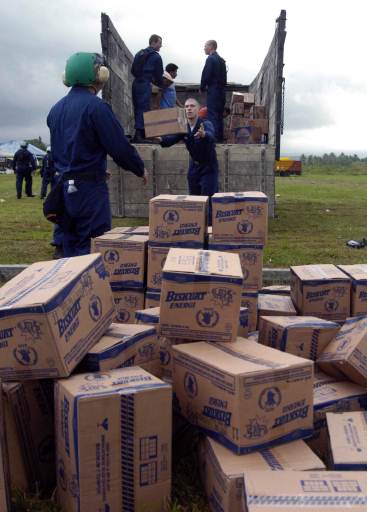
U.S. Navy sailors from the aircraft carrier USS Abraham Lincoln (CVN 72) unload humanitarian relief supplies from a truck at a helicopter-landing zone on the island of Sumatra, Indonesia, on Jan. 2, 2005. The supplies will be loaded aboard helicopters from Carrier Air Wing 2 for distribution to areas devastated by the Dec. 26, 2004, tsunami that struck the Indian Ocean. DoD photo by Petty Officer 2nd class Philip A. McDaniel, U.S. Navy. (Released)

U.S. Airmen, Marines, and members of an Indonesian Bomb Squad and Fire Department unload jerry cans, body bags, and other supplies off of a C-130 from Yokota Air Base, Japan, on Jan. 2, 2005, in Banda Aceh, Sumatra, Indonesia. DoD photo by Staff Sgt. Cohen A. Young, U.S. Air Force. (Released)
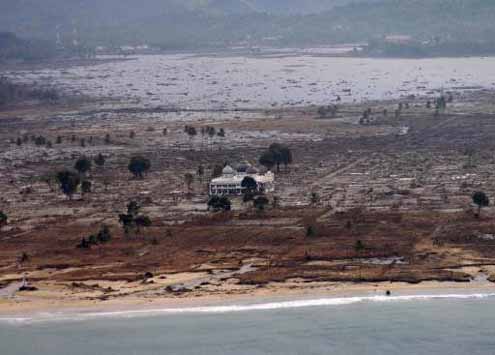
A mosque is all that remains in a costal village on the island of Sumatra, Indonesia, on Jan. 2, 2005. The village is one of many destroyed by the tsunami that struck the Indian Ocean on Dec. 26, 2004. The Abraham Lincoln Carrier Strike Group is currently operating in the Indian Ocean off the waters of Indonesia and Thailand, supporting humanitarian relief operations throughout the region. DoD photo by Photographer's Mate 2nd Class (AW/SW/PJ) Philip A. McDaniel, U.S. Navy. (Released)
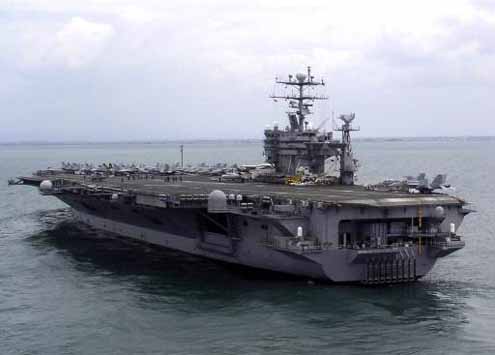
USS ABRAHAM LINCOLN (CVN 72) operates in the Indian Ocean near the coast of Banda Aceh in Sumatra, Indonesia, on Jan. 1, 2005. The "Golden Falcons" of Helicopter Anti-Submarine Squadron Two (HS-2) and the "Saberhawks" of Helicopter Anti-Submarine Light Squadron Forty-Seven (HSL-47) are supporting humanitarian relief efforts to the tsunami-stricken coastal regions by airlifting supplies and transporting military disaster relief teams. DoD photo by U.S. Navy. (Released)
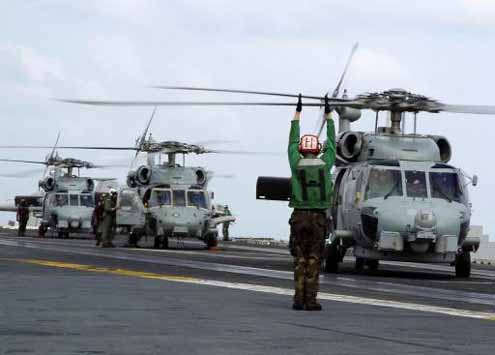
Helicopters from Helicopter Anti-Submarine Squadron Two (HS-2) and Helicopter Anti-Submarine Light Squadron Forty-Seven (HSL-47) take-off from USS ABRAHAM LINCOLN (CVN 72) to deliver humanitarian relief supplies and disaster relief teams to tsunami-stricken regions of Banda Aceh, Sumatra, Indonesia, on Jan. 1, 2005. The Abraham Lincoln Carrier Strike Group is currently operating in the Indian Ocean off the waters of Indonesia and Thailand. DoD photo by Photographer's Mate 2nd Class Seth C. Peterson, U.S. Navy. (Released)
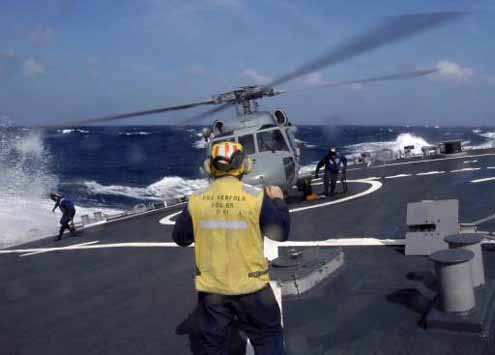
Sailors aboard guided missile destroyer USS BENFOLD (DDG 65) prepare an MH-60S Knighthawk helicopter for departure on Jan. 3, 2005, as Bendold makes a tight turn in the Indian Ocean off the coasts of Indonesia and Thailand. Benfold is assigned to Carrier Strike Group Nine (CSG-9), currently providing humanitarian relief to areas desimated by the Dec. 26, 2004, tsunami that stuck the Indian Ocean. DoD photo by Photographer's Mate Airman Ronald Dallatorre, U.S. Navy (Released)
